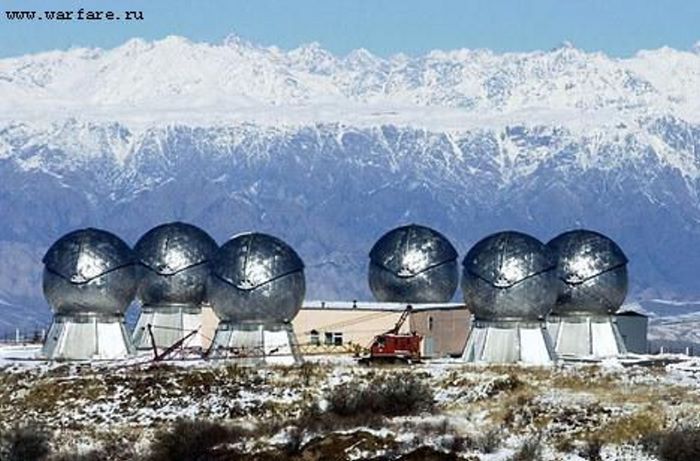|
Tajikistan |
|
|
.... by Staff Writers
Russia's Space Forces will significantly improve the technical capabilities of its main space-monitoring installation in Tajikistan, a deputy commander of the Okno center said Wednesday. Russia's Okno (Window) space-monitoring complex, located at an altitude of 2,200 meters (about 7,200 feet) in the mountains near the Tajik eastern city of Nurek, was commissioned in March 2004. It is a unique space-monitoring installation capable of tracking space objects orbiting the Earth at altitudes 2,000-40,000 kilometers (1,300-25,000 miles). "We are planning to expand its detection range [of the complex], and improve its tracking precision and servicing period through the modernization of its electronic equipment," Colonel Alexander Redin said. The Okno system is fully automated. It performs autonomous monitoring sessions at night in real time, constantly processing information about detected space objects. Detection is passive, based on reflection of the sun's rays from the surface of space objects, which allows it to consume a small amount of energy. "The role of the center is particularly important in emergency situations, such as a loss of communication with spacecraft or a malfunction of on-board telecommunications systems," Redin said. Source: RIA Novosti |
|
|
....
Okno ELINT complex in TajikistanThe Duma will discuss the Russian-Tajik accord on
transfer of the military object to Russian jurisdiction in the near future.
The government of Russia voted to forward the accord for ratification by
the Duma the other day. The matter concerns Nurek, an ELINT center of the
airspace control known in the Russian Defense Ministry as Okno or Window.
Press service of the government of Russia reports that the accord on the center signed on October 16, 2004, in Dushanbe was endorsed and about to be forwarded to the Duma for ratification. Lieutenant General Alexander Kvasnikov, Chief-of-Staff and Senior Second-in-Command of the Russian Space Forces, will represent the government of Russia in ratification procedures at the Federal Assembly. 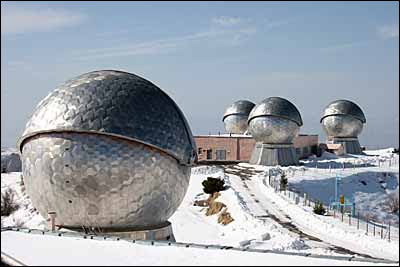
Okno ELINT complex in Tajikistan The choice is actually logical. Kvasnikov is one of Okno designers. Kvasnikov and a team of Russian scientists became laureates of the State Award of the Russian Federation in 2004. The scientists in question include Valery Kolinko, Director of Design Bureau No 4 of the Center of Science of the Zverev Krasnogorsk Factory, and Arkady Bereshkin, Director of Complex No 57 of the Television Research Center. Experts regard Okno center in Tajikistan as Russia's most valuable military object on the territory of the republic. The military-strategic role it is playing is already colossal and it is bound to increase yet. In other words, the Okno's military-political importance is going to be substantial in the relations between Moscow and Dushanbe. Located in the Sanglok mountains 2,200 meters above the sea level, the complex in question is one of the most efficient means of the airspace control system of the Russian Space Forces. The skies above it are clear almost all year round. 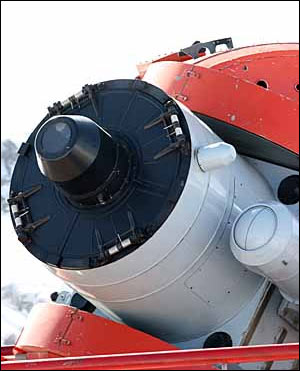
Okno ELINT complex in Tajikistan Okno Commander Colonel Sergei Chistyakov says that the complex automatically detects objects in the altitudes ranging between 2,000 and 40,000 kilometers, collects all available information on them, calculates their orbits and trajectories, and flashes the information to command centers. The complex may even be used to keep track of the targets in the altitudes of between 120 and 2,000 kilometers. Airspace is monitored at night when objects in space reflect sunlight and the reflection provides the complex with the necessary information. Okno is fully automatic. It may operate without human supervision, keeping track of the known and newly detected objects. Since the complex operates in the passive mode, it does not use too much of electric power. (In fact, it needs as much as a house of 150 apartments uses.) 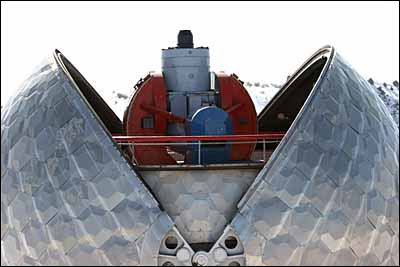
Okno ELINT complex in Tajikistan The US Department of Defense has three similar objects. They use lasers and therefore require more by way of electric power. In any case, Okno is superior. Strategically speaking, the complex is a huge step forward in Russia's ability to forecast aggressions against it and its allies. An emphasis on advanced hi-tech weapons and military hardware is made in modern warfare. Space is playing an important role in it, particularly now that the United States is deploying a new ballistic missile defense system with some elements of it in orbit around Earth. It means that the role of Okno in military security of Russia and its allies will only grow. 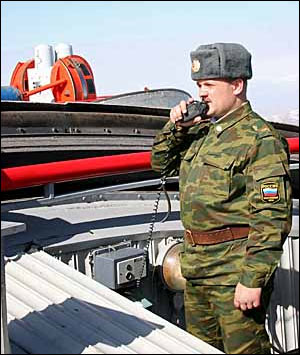
Okno ELINT complex in Tajikistan |
|
| The Russian Federation Ministry of Defence | |

Russian Army Krona Radar Page |
|
| FAIR USE NOTICE: This page contains copyrighted material the use of which has not been specifically authorized by the copyright owner. Pegasus Research Consortium distributes this material without profit to those who have expressed a prior interest in receiving the included information for research and educational purposes. We believe this constitutes a fair use of any such copyrighted material as provided for in 17 U.S.C § 107. If you wish to use copyrighted material from this site for purposes of your own that go beyond fair use, you must obtain permission from the copyright owner. | |
|
|
